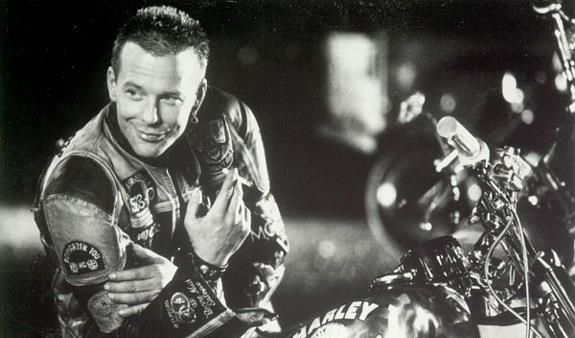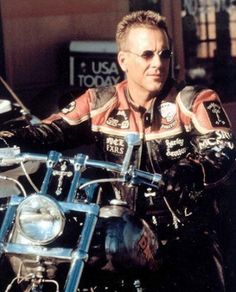

One of the most striking aspects, in the Biker world, is definitely the clothing. Most groups tend to conform over time - within their specific realities - as well as with the vests on which to put the colors, even with a certain very personal fashion, or trend in dressing. It is therefore easy to come across groups where jeans and jackets - in black leather or camouflage - are the masters. Even among those who do not live the life of the club there is still a recurring habit of conforming to that particular aspect that immediately makes one think of the Biker, when crossing a motorcyclist. However, the jacket is a must, an indispensable garment present in the collective imagination. From the celebrated "Blouson noir" to Marlon Brando in the movie "The Wild" to the spectacular evolution of the garment, with technical inserts and multicolored patches, well represented in other films such as in "Harley Davidson & Marlboro Man" where Mickey Rourke was towering with his vest become , since then, a kind of icon. Precisely this in particular has often been talked about, in consideration of the fact that, having become a real "object of desire" by the public, it is easy to find accurate replicas for sale on the internet. And although the cost is really high - it easily reaches almost a thousand euros - there is no shortage of buyers. But how many have wondered the meaning of the many patches that adorn it? Let's try to examine them, while remembering that the original was conceived and designed by Rourke himself and made in California by ZED Custom Leather. The Z appears prominently on the back, at the bottom, under the word HARLEY on the shoulder, the central lightning bolts and the DAVIDSON rocker at the bottom. It is interesting to note that, very wisely, the fundamental mistake of making the two rockers at the top and bottom, and a central logo, was avoided in the realization, because it is well known that it is only allowed to official and recognized motorcycle clubs. The other patches unfold on the arms and front, let's see them. First of all, one particular is curious, the commemorative patches of deceased friends and family members are all on the left side of the head: it is in fact a tradition, an unwritten convention, among tattoo artists above all, that the left side of the body is dedicated to the family, with names of children, portraits of loved ones or the classic funeral images of cemeteries and tombstones with the names of dead friends and relatives. While the right side of the body, especially the arms, are dedicated to tattoos - and consequently, in our speech, to patches - relating to one's own interests or the “family”, the club. In fact, it is easy to find bikers who have the Club logo tattooed on their right arm and the names of their children or portraits on the left. So, even on Mickey Rourke's jacket we find these things: on the chest, on the left, the cards of the "Hand of the Dead", under each of which the initials of relatives and friends. Here we see a big difference, however, from the original legend; the "Hand of the Dead" were the cards held in hand by Wild Bill Hickok, the famous American gunslinger, while he was shot down during a poker game on August 2, 1876, in Deadwood, and they were five, not eight. Of these two were aces and two eight, black in color. On the fifth we have always wondered and conventionally we tend to believe he was a joker. This particular combination is believed to be the maximum of bad luck by the players. Rourke, wishing to include more initials of relatives and friends, put eight. Under this, another patch commemorates the EVOLUTION, Harley Davidson 1340cc carburetor. On the left arm, remaining in the perspective of homage to the dead, two other patches appear: on the upper one a Celtic cross surmounted by the motto "Tiocfaidh Ar-la" recalls the PIRA fighter Bobby Sands, who died in Long Kesh prison, in 1981 at the end of a devastating hunger strike together with ten other militants of the Irish Liberation Army. Bobby Sands uttered this phrase "Our day will come" in Gaelic and it was later adopted by the Provisional Irish Republican Army. The other patch recalls, with the inscription SRV-MCMLVI-XC S.R.V., the year of birth and death of the blues singer Steve Ray Vaughan, a friend of Rourke. Curious how in some commercial replicas of the jacket this patch also appears on the front, at the bottom. On the right front of the jacket we find other indications, more linked - as explained above - to Rourke's passions or to the film in which he appeared, precisely “Harley Davidson & Marlboro Man”. The first, at the top, advertises the Bartel’s HD, the American workshop that built the motorcycle - in three examples - used in the movie.

The second recalls MCB, that is "Motorcycle Boy", the nickname of the character played by Rourke in the 1983 film "Rusty the Savage, by Coppola, where he plays the older brother of the protagonist, a disbanded biker destined for a tragic end in a drama masterfully crafted with the use of highly dramatic black and white. FXRS is the Harley code of the motorcycle type. Finally, at the bottom we find again a Celtic cross with two small red crosses and glyphs around it, a patch whose meaning has remained unspecified but which is presumed to relate to the religious roots of Rourke. Moving on to examine the right arm, in addition to noting how this too, in certain commercial replicas, features different patches or in addition to the original of the film, we find the German name of the bike, or Death Star, "Schwarzer Tod". To go down, an orange colored patch with a firebird - the Thunderbird, cult totem of the American Indians - and the words WYOMING OUTLAW. This, which is the title of a 1939 film by George Sherman, released in Italy in 1965 mixed with another "Santa Fe Stampede" film with the unique title of "The Great Spur", sees the deeds of a young John Wayne and it's about an outlaw on the run from the police. In fact, we recall that the stampede were the groups of hunters who gathered independently to chase the criminals after the robberies of banks or trains, in the Wild West. Wyoming Outlaw is the nickname given by Rourke to the model Carrè Otis whom he married in 1992 and from whom he divorced in 1998 after years of abuse, head shots, drugs and betrayal. Rourke seemed to have remained romantically linked to Otis, who had the opportunity to narrate in interviews and autobiographies a relationship that made her leave the world of cinema and a promising career. Another patch on the arm recalls the 50th "Sturgis" rally in 1990, held in South Dakota. The first rally was organized in 1938 by the Jackpine Gypsies, dedicated to Indian motorcycles, and was called the “Black Hills Classic”, founded by Clarence “Pappy” Hoel. It is estimated that in 2015 almost nine hundred thousand people participated. The latest irreverent patch that makes a fine show of itself, reads "Bonne nuit salope", literally "good night whore" and refers to a line from the film. As we have seen, as a whole the jacket is rightfully placed among those usually worn by free bikers, who love to sew all kinds of writings and commemorative patches of motorcycle rallies; certainly such an object is light years away from the "uniforms" worn by club members but it still has its own undeniable charm, as well as the kaleidoscopic, bundled up vests that run in many motorcycle rallies. And clearly, let's not underestimate the importance of Rourke's charismatic charm, to which - at least at the time of the movie "Harley Davidson & Marlboro Man" - certainly many would like to resemble.

Papa Doc for MPM GENS